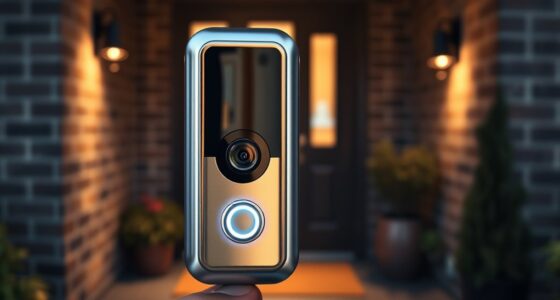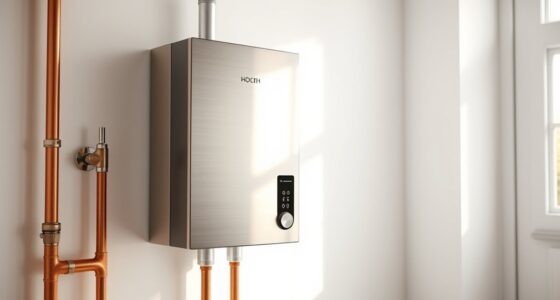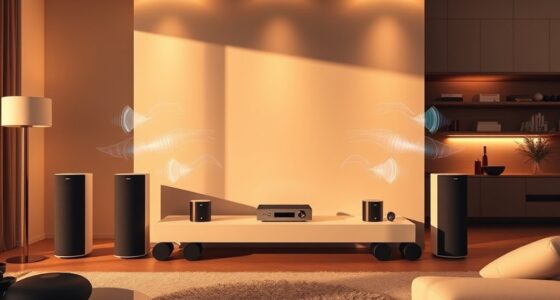With 5G networks, your smart home can communicate faster and more reliably, making device control seamless and intuitive. You’ll experience instant responses to commands, improved energy management, and the ability to support more connected gadgets without lag or disconnections. Enhanced security features protect your devices, while automation routines become smarter. If you want to discover how 5G can transform your home into a more efficient, secure, and responsive space, you’ll find more insights ahead.
Key Takeaways
- Enables seamless communication and integration of multiple smart devices from a single platform.
- Provides instant responses and low latency for real-time home automation and security.
- Supports rapid data transfer for better energy management and consumption insights.
- Maintains network stability and supports many connected devices without slowdown.
- Enhances security and automation capabilities through improved protocols and reliable performance.

As 5G technology becomes more widely available, it is transforming the way smart homes operate. With ultra-fast connectivity, your smart devices can communicate more efficiently, creating a seamless and responsive home environment. Smart device integration becomes smoother, allowing various gadgets—like thermostats, security cameras, lighting systems, and appliances—to work together effortlessly. This means you can control and monitor everything from a single app or voice command, reducing the hassle of juggling multiple platforms. The low latency of 5G ensures real-time responses, so your smart home reacts instantly to your commands or changing conditions, making everyday tasks more convenient and efficient.
Energy management is also considerably enhanced with 5G. Smart meters and energy-consuming devices can transmit data more rapidly, giving you a clearer picture of your home’s energy use in real-time. This allows you to optimize your energy consumption, reduce waste, and lower utility bills, all without sacrificing comfort. For instance, your smart thermostat can adjust the temperature based on your habits and preferences, and communicate instantly with your energy provider if needed. Additionally, 5G enables more sophisticated automation routines, such as turning off appliances when not in use or adjusting lighting based on occupancy, all coordinated through a robust network that handles multiple devices simultaneously without lag.
The increased bandwidth provided by 5G also means your smart home can support a greater number of devices without sacrificing performance. This is essential as homes become more connected, with gadgets multiplying rapidly. You won’t experience sluggishness or disconnections, even when multiple devices are streaming, downloading, or updating simultaneously. This stability is fundamental for security systems that rely on constant, reliable data transmission to function properly. Moreover, with 5G’s ultra-reliable connections, you can integrate more advanced smart home features, like augmented reality interfaces for maintenance or troubleshooting, further enhancing your home automation experience. Furthermore, network security protocols are improved with 5G, providing better protection for your connected devices against cyber threats.
Frequently Asked Questions
How Does 5G Impact Energy Consumption in Smart Homes?
You might find that 5G impacts your smart home’s energy consumption by making devices more energy-efficient, reducing overall power use. Faster connectivity enables smarter scheduling, better device coordination, and optimized energy management, which cuts down on unnecessary power consumption. While some devices may require more power initially, overall, 5G helps improve energy efficiency, leading to lower power consumption and a more sustainable, eco-friendly home environment.
Are There Any Health Risks Associated With 5G in Smart Homes?
You might wonder if 5G poses health risks, but current research shows radiation exposure from 5G is well below safety limits set by health authorities. In fact, the World Health Organization states there’s no conclusive evidence linking 5G to health concerns. With billions of devices connected, understanding these risks helps you stay informed and confident, knowing that 5G’s radiation exposure remains within safe boundaries for your smart home environment.
How Does 5G Improve Security for Smart Home Devices?
You benefit from enhanced security with 5G because it uses advanced wireless encryption to protect your data, making it harder for hackers to access your smart home devices. Additionally, 5G improves device authentication, ensuring only authorized devices connect to your network. This combination strengthens your smart home’s security, giving you peace of mind and reducing the risk of cyber threats.
What Are the Costs Involved in Upgrading to 5g-Enabled Smart Homes?
Upgrading to 5G-enabled smart homes involves installation costs and subscription fees. You’ll pay for new equipment, like 5G routers and compatible devices, and ongoing fees to access the high-speed network. You might also face costs for professional installation and increased energy use. While the investment can be significant, you gain ultra-fast connectivity, improved security, and future-proofed technology, making your smart home more efficient and responsive in the long run.
Will 5G Eliminate the Need for Wi-Fi in Smart Homes?
No, 5G won’t eliminate the need for Wi-Fi in your smart home. While 5G provides ultra-fast connectivity and can serve as a primary connection, Wi-Fi remains essential for local smart home devices that require reliable, low-latency access. You’ll benefit from 5G redundancy, ensuring your smart home stays connected even if Wi-Fi goes down. Combining both offers seamless smart home connectivity and maximizes network reliability.
Conclusion
Embracing 5G in your smart home isn’t just about faster connections; it’s about opening a new level of convenience and efficiency. While some skeptics argue that existing Wi-Fi can suffice, the ultra-fast, low-latency benefits of 5G suggest it could revolutionize device interconnectivity. As technology advances, it’s worth considering whether 5G will truly deliver on these promises or if it’s just a future trend. Either way, it’s clear that ultra-fast connectivity is shaping how we live.








